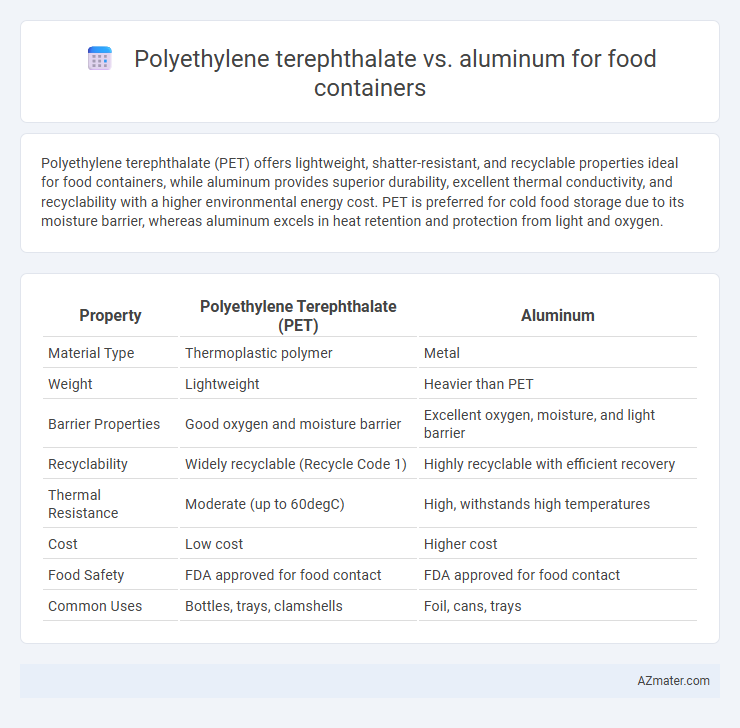Polyethylene terephthalate (PET) offers lightweight, shatter-resistant, and recyclable properties ideal for food containers, while aluminum provides superior durability, excellent thermal conductivity, and recyclability with a higher environmental energy cost. PET is preferred for cold food storage due to its moisture barrier, whereas aluminum excels in heat retention and protection from light and oxygen.
Table of Comparison
| Property | Polyethylene Terephthalate (PET) | Aluminum |
|---|---|---|
| Material Type | Thermoplastic polymer | Metal |
| Weight | Lightweight | Heavier than PET |
| Barrier Properties | Good oxygen and moisture barrier | Excellent oxygen, moisture, and light barrier |
| Recyclability | Widely recyclable (Recycle Code 1) | Highly recyclable with efficient recovery |
| Thermal Resistance | Moderate (up to 60degC) | High, withstands high temperatures |
| Cost | Low cost | Higher cost |
| Food Safety | FDA approved for food contact | FDA approved for food contact |
| Common Uses | Bottles, trays, clamshells | Foil, cans, trays |
Introduction to Food Packaging Materials
Polyethylene terephthalate (PET) and aluminum are two prominent materials used in food packaging, each offering distinct advantages in preserving product freshness and extending shelf life. PET, a lightweight, transparent polymer, provides excellent barrier properties against moisture and gases, making it ideal for beverages and perishable goods. Aluminum, renowned for its exceptional durability and complete light and oxygen barrier, is commonly used for packaging items that require long-term storage and protection from contamination.
Overview of Polyethylene Terephthalate (PET)
Polyethylene Terephthalate (PET) is a lightweight, durable polymer widely used for food containers due to its excellent clarity, high strength, and chemical resistance. PET is highly recyclable and provides an effective barrier against moisture and gases, maintaining food freshness and extending shelf life. Compared to aluminum, PET offers superior transparency for product visibility and is less prone to denting or deformation during handling and transportation.
Properties of Aluminum for Food Containers
Aluminum is highly valued for food containers due to its excellent thermal conductivity, lightweight nature, and superior barrier properties against light, oxygen, and moisture. Its corrosion resistance and recyclability contribute to sustainability, ensuring food safety and prolonged shelf life. Furthermore, aluminum's malleability allows easy shaping into various container forms without compromising structural integrity.
Comparative Barrier Properties: PET vs Aluminum
Polyethylene terephthalate (PET) offers moderate oxygen and moisture barrier properties suitable for short-term food storage but is permeable to gases compared to aluminum. Aluminum provides an exceptional barrier against oxygen, moisture, light, and contaminants, extending shelf life significantly for sensitive food products. The choice between PET and aluminum depends on the required shelf life, storage conditions, and the specific barrier performance needed for preserving food quality.
Environmental Impact and Sustainability
Polyethylene terephthalate (PET) offers lightweight properties and is recyclable, but it relies heavily on fossil fuels and can contribute to plastic pollution when not properly managed. Aluminum containers, though energy-intensive to produce initially, boast high recyclability rates with closed-loop recycling systems that significantly reduce their environmental footprint over time. Choosing aluminum over PET enhances sustainability due to its infinite recyclability and reduced greenhouse gas emissions in recycled production phases.
Food Safety and Chemical Leaching Concerns
Polyethylene terephthalate (PET) is widely used for food containers due to its strong resistance to chemical leaching and excellent food safety profile, meeting FDA standards for direct food contact. Aluminum containers provide excellent barrier properties against light, oxygen, and moisture but may pose potential risks of aluminum leaching into acidic or salty foods, which raises food safety concerns. Food packaging regulations emphasize selecting materials like PET for minimizing chemical migration, while aluminum containers often require internal coatings to prevent direct metal-to-food contact and ensure consumer safety.
Cost Efficiency and Production Scalability
Polyethylene terephthalate (PET) offers superior cost efficiency due to lower raw material costs and energy requirements compared to aluminum in food container production. PET's lightweight nature enables more efficient transportation and reduced storage expenses, enhancing overall cost-effectiveness. Production scalability favors PET with faster molding cycles and easier customization, whereas aluminum fabrication involves more complex processes and higher capital investment.
Recyclability and End-of-Life Considerations
Polyethylene terephthalate (PET) offers high recyclability with widespread infrastructure supporting its recovery and transformation into new packaging, reducing environmental impact and conserving resources. Aluminum containers feature near-infinite recyclability, with recycled aluminum retaining properties and requiring only 5% of the energy compared to primary production, making it highly sustainable for end-of-life management. While PET recycling can be limited by contamination and degradation, aluminum's robust recycling loop and value retention ensure superior lifecycle performance in food container applications.
Common Applications in Food Packaging
Polyethylene terephthalate (PET) is widely used for beverages, ready-to-eat meals, and fresh produce packaging due to its clarity, lightweight nature, and excellent barrier properties against moisture and gases. Aluminum containers are preferred for high-heat applications like baking, grilling, and long-term food storage because of their superior thermal conductivity and durability. Both materials are essential in the food packaging industry, with PET favored for consumer convenience and visual appeal, while aluminum is chosen for preservation and cooking efficiency.
Choosing the Right Material for Specific Needs
Polyethylene terephthalate (PET) offers excellent clarity, lightweight properties, and resistance to moisture, making it ideal for packaging fresh foods and beverages that require visibility and durability. Aluminum containers provide superior barrier protection against light, oxygen, and contaminants, which extends shelf life and is preferred for heat-sensitive or long-term food storage. Selecting between PET and aluminum depends on factors like food type, storage duration, environmental impact, and cost-efficiency to ensure optimal preservation and consumer safety.

Infographic: Polyethylene terephthalate vs Aluminum for Food Container
 azmater.com
azmater.com